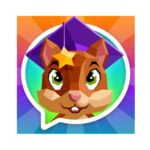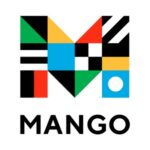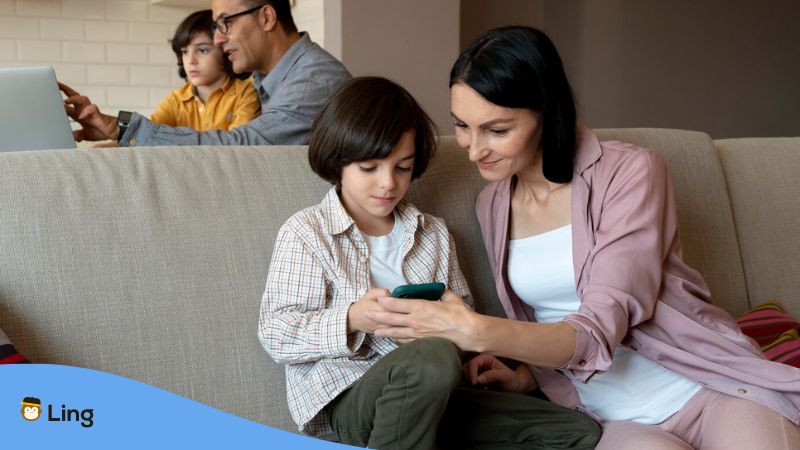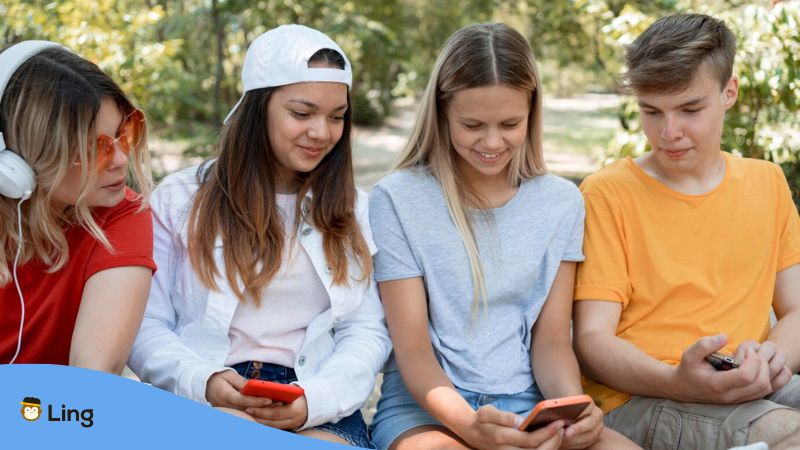With so many language learning resources for kids on the market these days, it can be tricky to identify which ones are truly the best. As a parent who wants to nurture multilingual abilities in my children, I’ve spent my fair share of time researching and testing out the various options.
The key is to find resources to make learning entertaining and intuitive for young minds. Ideally, they should feel more like play than rigid study for children. At the same time, they need to leverage proven techniques like immersion, repetition, and practical conversation to be effective.
The Ling app alone hits those sweet spots, engaging kids’ natural curiosity while helping them gain fundamental proficiency. But to give you other online language learning resources for kids, let me share with you what I’ve found out.
Quick Summary:
Best For
Apps

Ling
- Chatbot and interactive speaking practice
- Fun writing exercises
- Gamified learning experience

Mondly Kids
- Voice recognition technology
- Daily fresh lessons
- Augmented reality for a more interactive experience

Mango Language
- Cultural insights
- Memory building activities
- Speech recognition technology
1. Ling App: Best For Comprehensive Language Learning
(Suitable for ages 4 and up.)
If I had to choose just one all-encompassing language-learning resource for my kids, the Ling app would be it. With over 60 languages to explore, it provides a rich playground for young learners at any level. My eldest daughter is currently using the Ling app to pick up beginner Spanish, while my wife is honing her intermediate Cantonese skills.
The Ling app’s lessons feel more like fun games than boring grammar drills. The app features varied activities, from building vocabulary by matching image cards to completing listen-and-repeat exercises for phrases in context. Challenging quizzes reinforce retention, earning kids rewards to motivate them.
What I actually appreciate about the Ling app is how thoughtfully designed the curriculum is. The lessons are crafted by real linguists and native speakers, not just programmers, so the methodology is sound. The content builds up incrementally from simple to complex concepts. Rather than just memorizing random words and sentences, kids acquire the underlying logic of the language.
Transform Your Language Skills in a Week for Free – Get the Ling App Today
Devices: Android, iOS, Web
Features
- AI-Based Chatbot: Offers interactive speaking practice, which enhances conversational skills in a fun, responsive way.
- Writing Exercises: Improves language retention through muscle memory. This is crucial for mastering writing systems.
- Sync Across Devices: Allows learning continuity, whether on mobile or computer, making it flexible for busy families.
Pricing
- Free with beginner lessons and an introductory Chatbot.
- Monthly: $14.99
- Six Months: $39.99
- Yearly: $79.99 (7-day free trial)
- Lifetime: $149.99

2. Mondly Kids: Best For Interactive Learning Experiences
(Best for ages 5-12, while the main app suits all ages.)
If your child is an active, hands-on learner, Mondly delivers where some language learning resources fall short. With 41 languages to pick from, it keeps kids engaged with interactive lessons that feel like games rather than studying.
One of Mondly’s key features is speech recognition technology that lets young learners practice conversational skills. They can speak phrases out loud and receive instant feedback on pronunciation. This makes picking up accurate speaking habits so much easier than trying to mimic recordings alone.
Mondly prioritizes practical, everyday language used in real-life situations. Lessons center around topics like introducing yourself, ordering food, and giving directions rather than grammar principles.
Devices: Android, iOS, Web
Features
- Voice Recognition Technology: Accurate feedback on pronunciation, making language practice more effective.
- Daily Lessons: Keeps learning fresh and consistent with new, engaging content every day.
- Augmented Reality (AR): Offers an immersive experience that blends real-world surroundings with language learning.
Pricing
- Free with basic daily lessons.
- Monthly premium (one language): $9.99
- Yearly premium (one language): $47.99
- Lifetime (all languages): $89.99
3. Mango Languages: Best For Developing Conversational Skills
(Ideal for ages 6 and up.)
Building the confidence to actually converse in a new language can be challenging for kids. Mango Languages provides the right toolkit, with lessons based on practical dialogues and a simple conversational methodology.
One thing I like is how Mango Languages structures its content around real-life, culturally contextual conversations. For example, your children can learn phrases for greeting their friends in Spain and ordering gelato in Italy. This immersive approach gives kids the confidence to navigate interactions in their target language.
I also appreciate Mango’s “Daily Review” system for reinforcing previous material. Short, interactive sessions ensure kids don’t lose what they learn. With 71 languages available, Mango Languages is ideal for igniting conversational curiosity.
Devices: Android, iOS, Web
Features
- Cultural Insights: Integrates cultural learning that provides a richer, more contextual language experience.
- Speech Recognition Technology: Enhances pronunciation, offering real-time corrective feedback.
- Memory Building Activities: Reinforces language retention with practical, engaging exercises.
Pricing
- Free for the first lesson only.
- Premium for single language: $79.99/year ($7.99/month)
- Premium for all languages: $179.99/year ($17.99/month)
- Enterprise plan: Contact Sales

4. Muzzy BBC: Best For Story-Based Learning
(Designed for children 2 to age 12 or older.)
Let’s say your kids love imaginative stories as mine do. Well, Muzzy is a delightful way for them to absorb new languages. Its charming characters and narratives create an engaging world that makes learning feel like an adventure.
Muzzy BBC uses episodic storytelling to teach everything from vocabulary and grammar to pronunciation in an intuitive way. By following along with the fun adventures of Muzzy and his friends, it won’t feel like “learning” to your little ones. The stories are filled with repetition of key phrases, which helps them stick.
The appeal for visual learners is the colorful illustrations and animations that accompany the interactive stories. There are also games and songs built into Muzzy that aid memorization and recall through play. If a creative, narrative approach appeals, Muzzy should be one of the best immersive language apps today.
Devices: Android, iOS, Web
Features
- Episodic Storytelling: Uses continuous narratives for a more immersive learning experience.
- Colorful Illustrations and Animations: Engages visual learners with vibrant, captivating content.
- Interactive Games and Songs: Reinforces learning through playful, memorable activities.
Pricing
- 3 months subscription: $30.00 ($10/month)
- Yearly subscription: $75.00 ($6.25/month)
- 2 years subscription: $95.00 ($3.96/month)
5. Little Pim: Best For Early Language Learning
(Good for kids ages 1 to 6.)
When it comes to teaching languages to preschoolers and early elementary students, Little Pim is a playful powerhouse. The friendly panda mascot keeps things fun and engaging for children.
Little Pim brilliantly breaks down the language into bite-sized pieces suitable for shorter toddler attention spans. But that’s not all. There are videos and activities focusing on vocabulary related to daily life and familiar objects.
There is also repetition of vocabulary words in multiple engaging contexts, which aids retention of what they’ve learned. By associating sounds and meanings in a conversational way, Little Pim lays a strong language foundation.
Devices: Android, iOS, Roku, Web
Features
- Entertainment Immersion Method®: Engages young learners with entertaining content while teaching language.
- Short Attention Span Format: This feature is tailored to young children and keeps them engaged without overwhelming them.
- Contextual Vocabulary Learning: Focuses on daily life and familiar objects, making language relatable and easier to grasp.
Pricing
- Free with minimal features and no offline activities and printables.
- Monthly premium: $9.99
- Yearly premium: $69.99

6. Rosetta Stone: Best For Immersive Learning
(Suitable for ages 6 and up, including adults.)
If you’re looking for serious language gains fast, Rosetta Stone packs a punch. Its acclaimed methodology relies on full immersion, without translation, to mimic how we naturally learn languages as kids. Even as an adult language learner, I’ve found it incredibly effective.
Rosetta Stone teaches intuitively, connecting sounds, images, text, and interactions to build an instinctive understanding of the language. Lessons are packed with photos, realia, and activities that draw learners in, too.
Having access to live tutoring sessions makes Rosetta Stone well-suited for motivated young learners. While pricier than most language learning resources for kids, this powerful immersion method delivers results.
Devices: Android, iOS, Web
Features
- Dynamic Immersion® Method: Mimics natural language acquisition that provides an intuitive learning experience.
- Live Tutoring Sessions: Offers personalized practice to strengthen conversational and listening skills and boost confidence.
- TruAccent™ Speech Recognition Engine: Provides precise feedback on pronunciation, aiding in fluent speech development.
Pricing
- 3-month premium: $47.97 ($15.99/month)
- Yearly premium: $167.88 ($13.99/month)
- Lifetime subscription: $399.00
7. Dinolingo: Best For Gamified Language Learning
(Best for ages 2 to 12.)
For the youngest language learners, Dinolingo brings a playful and engaging twist to learning. Its amusing dinosaur characters, friends, and simple games make acquiring new languages fun for preschoolers.
Dinolingo’s lessons involve songs, stories, flashcards, and interactive games with built-in repetition to aid retention. Kids also earn stickers and rewards as positive reinforcement. At the same time, the friendly interface and variety of activities will keep even your antsy 4-year-old engaged.
There are 50 languages available, so there’s something for every child’s interest. Dinolingo cleverly uses the motivators kids love – cute characters, silly songs, and games with prizes to encourage language learning. It takes advantage of short attention spans to foster playful participation.
Devices: Android, iOS, web.
Features
- Dinosaur-Themed Characters and Stories: Makes learning appealing and relatable to young children.
- Sticker and Reward System: Motivates learners with positive reinforcements for their progress.
- Diverse Range of Language Activities: Ensures a comprehensive learning experience through varied formats like flashcards, songs, and stories.
Pricing
- Family plans:
- Monthly: $14.95
- Yearly: $149.00
- Yearly for All Languages: $449.00
- Monthly: $14.95
- They also have specific plans for schools, language teachers, and tutors.

More Language Learning Resources For Kids
Your option of language learning resources for kids extends beyond our top picks. Here are other valuable language-learning apps and websites, each bringing something special to the table:
- ABCYA: A blast of games and activities in English and Spanish for pre-K to 6th graders. Blends education with playtime into young learner engagement.
- ChatGPT: AI language model from OpenAI useful for linguistics practice, with lightning-fast Q&A.
- Duolingo: User-friendly language app with diverse lessons and daily practice that makes learning a breeze.
- LearnEnglishKids: Games, stories, and videos from the British Council, ideal for young speakers of all languages to grasp English.
- PBS “Oh Noah!”: Combines entertaining videos to build Spanish vocabulary through activities and games.
- TumbleBooks: Books, puzzles, and games in Spanish and French; a reading and language learning trove.
- YiddishPop: Animated magic specially crafted to captivate kids in learning Yiddish.
- PetraLingua: Engaging multimedia vocabulary builder in many languages that makes young minds gobble up new words.
- Languagenut: Vocabulary and pronunciation lessons for 23 languages, elementary to high school covered.
- Unuhi: Bilingual books galore, a storytelling avenue that simplifies language learning for kids.
- Studycat: 5 languages, interactive fun designed to ensure kids love every step of their lingo journey.
- Gus on the Go: 30 languages distilled into basic lessons made for younger learners.
- Fun Easy Learn: 62 languages presented through diverse, engaging themes that fit learners craving variety.
Why Do Kids Need To Learn A New Language?
To start, studies from Cornell Language Acquisition Lab (CLAL) demonstrate that children who know more than one language can sustain focus better. This vital skill paves the way for academic achievement.
Another thing is that learning a new language does not jumble kids’ speech or inhibit cognition. On the contrary, it boosts crucial abilities like memory, concentration, and self-control. For instance, bilingual kids excel at sorting information and switching between tasks quickly. The earlier children begin learning a second language, the faster they can attain native fluency.
Immersion programs are especially effective, too. When surrounded by the new language throughout the day, young students naturally absorb its vocabulary and grammar. A child who learns Spanish in an immersion kindergarten, for example, will likely grasp the language almost as easily as her native English.
In short, comprehensive language education enhances the development of minds and primes kids for future scholastic success. The cognitive flexibility, focus, and enriched perspective bilingualism provides give our beloved young learners an edge.
Let Your Child Learn Languages The Easy Way With Ling!
As we wrap up this review of top-notch language learning resources for kids, one gem still shines the brightest: the Ling app. With its fun, comprehensive approach to language mastery, the Ling app engages young learners, adults, and anyone determined to level up their linguistics.
Boasting over 60 languages, the Ling app has options galore to suit each learner’s interests. Lessons adapt to your level, whether you’re a newbie or nearly fluent, guiding you from basic vocabulary to smooth conversation.
Eager to experience the Ling app’s magic? Download now for Android and iOS and take advantage of the 7-day free trial. We’re confident one week is all it takes to get your kids’ language adventures rolling, and the Ling app kickstarts this journey to multilingual mastery, where global citizens take root.



































































